According provided by Canon Zoom Lens EF-S 18-55mm 1: 3.5-5.6 IS STM many thanks to the official representatives of Canon in Ukraine.
Canon Zoom Lens EF-S 18-55mm 1: 3.5-5.6 IS STM is a new versatile lens, introduced on March 21, 2013 with cameras Canon 100D и 700D... I would like to note that a huge number of different modifications were released for standard (so-called 'whale') Canon 18-55 / 3.5-5.6 lenses. Below is the entire list:
The simplest versions (without IS, USM, STM):
- Canon Zoom Lens EF-S 18-55mm 1: 3.5-5.6September 2004, Scheme 11/9 [1 ASP]
- Canon Zoom Lens EF-S 18-55mm 1: 3.5-5.6 II, March 2005, Scheme 11/9 [1 ASP]
- Canon Zoom Lens EF-S 18-55mm 1: 3.5-5.6 III, March 2011, Scheme 11/9 [1 ASP]
Versions with USM-motor:
- Canon Zoom Lens EF-S 18-55mm 1: 3.5-5.6 USMSeptember 2004, Scheme 11/9 [1 ASP]
- Canon Zoom Lens EF-S 18-55mm 1: 3.5-5.6 II USMMarch 2005, Scheme 11/9 [1 ASP]
Versions with Image Stabilizer IS:
- Canon Zoom Lens EF-S 18-55mm 1: 3.5-5.6 ISSeptember 2007 Scheme 11/9 [1 ASP]
- Canon Zoom Lens EF-S 18-55mm 1: 3.5-5.6 IS II, March 2011, Scheme 11/9 [1 ASP]
Versions with STM-motor and image stabilizer IS:
- Canon Zoom Lens EF-S 18-55mm 1: 3.5-5.6 IS STM, April 2013, Scheme 13/11 [1 ASP]
- Canon Zoom Lens EF-S 18-55mm 1: 4-5.6 IS STM, February 2017, Scheme 12/10 [1 ASP + SSC]
Versions for mirrorless cameras with bayonet mount Ef-m:
- Canon Zoom Lens EF-M 15-45mm 1:3.5-6.3 IS STM, October 2015, scheme 10/9 [3 ASP]
- Canon Zoom Lens EF-M 18-55mm 1: 3.5-5.6 IS STMSeptember 2012, Scheme 13/11 [3 ASP]
Version for mirrorless cameras with bayonet mount R (RF-S):
- Canon Lens RF-S 18-45mm F4.5-6.3 IS STM, May 2022, scheme 7/7 [2 ASP]

The main parameters of all Canon 18-55 for SLR cameras. increase.
All Canon whale lenses of class 18-55 / 3.5-5.6, except for the STM version presented in this review, have the same optical scheme, which includes 11 elements in 9 groups. It can be argued that new lens modifications were produced, but they were all built on the basis of the same optical scheme, first introduced in 2003 on lens Canon Zoom Lens EF-S 18-55mm 1: 3.5-5.6went on sale with the Canon 300D.
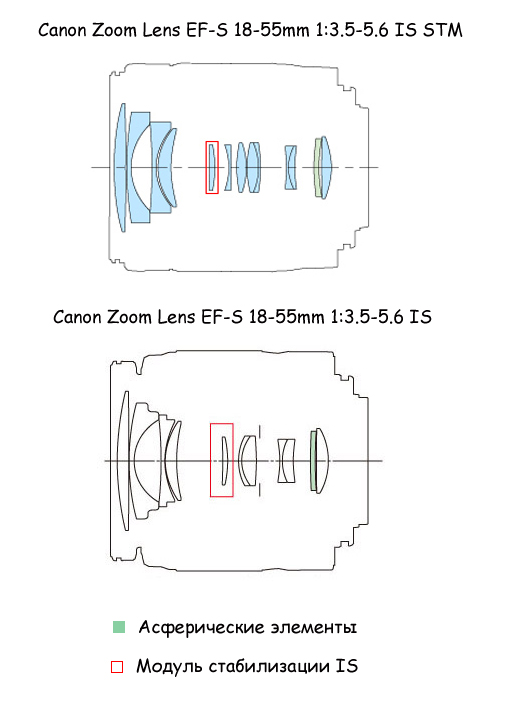
Optical design of two IS and STM lenses. Pictures taken from Canon Camera Museum
After 10 years, Canon apparently decided to release a new staffer, under the new multi-megapixel digital SLR cameras that require it. The new optical scheme includes 13 elements in 11 groups, including 1 aspherical element. It is also good that the new lens has an aperture with 7 blades, while previous versions had only 6 blades.
Canon EF-S 18-55 / 3.5-5.6 IS STM, like other similar lenses, has only 3x zoom, a small maximum aperture and built-in image stabilizer. The stabilizer works well, in practice, I did not notice much difference with the previous model ISII, the more it is stated that both lenses give a stabilization effect equivalent to 4 steps excerpts.
This lens weighs only 205 grams and is made in Taiwan. It has a plastic mount, which is quite normal for a budget lens. The zoom (zoom) ring is rubberized. When the focal length is changed, the lens trunk moves in a wave-like manner, decreases from 18 mm to 35 mm, and then lengthens again from 35 mm to 55 mm. When the focal length changes, the front lens does not rotate, but the rear lens moves, creating a slight vacuum cleaner effect (sucking in air, and with it dust).
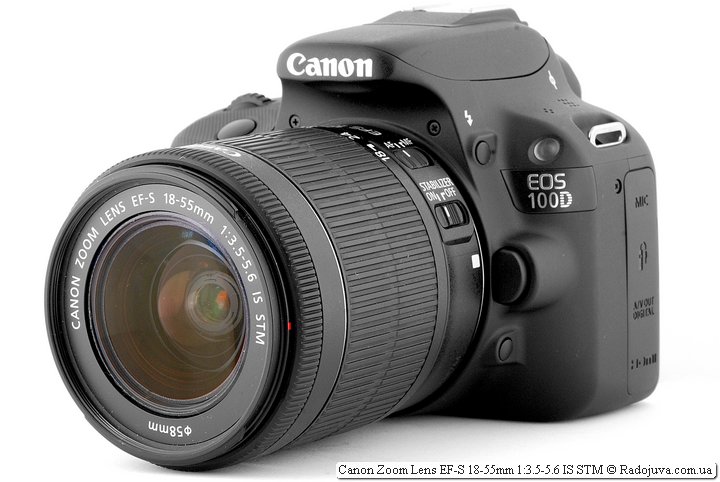
Canon EF-S 18-55 3.5-5.6 IS STM on Canon 100D
It is very good that the new STM lens has internal focusing - when focusing, the front lens does not rotate at all. This is useful for using special light filters (gradient, polarizing etc.). Prior to this, there was simply no internal focus on standard lenses of this class.
Canon EF-S 18-55 / 3.5-5.6 IS STM belongs to the new line of Canon STM lenses. STM — STepper Motor is a focusing stepping motor that enables smooth, quiet and fast focusing. Reality lived up to its promises - I was just amazed at the focusing speed on this little whale lens :).
In addition, the lens supports focus mode FTM — Full Time Manual Focusing - focusing mode with constant manual control. Prior to that, kit lenses of class 18-55 did not have such 'luxury'. You can grab the focusing ring at any time, press the focus button (usually the same button that is responsible for releasing the shutter) and manually correct the focus. You do not need to switch to 'MF' focus mode.
It is fair to say that the FTM mode does not work with the 'AI Servo' focusing method.
With the focusing of the lens, everything would be just fine, if not for one 'but'. The focusing ring of the lens is electronic, you can focus on focus only when the camera is on. The focusing ring is plastic, not rubberized, and most importantly - very flimsy. On my copy it has a noticeable backlash and taps at any touch to it, which spoils the whole impression of the lens.
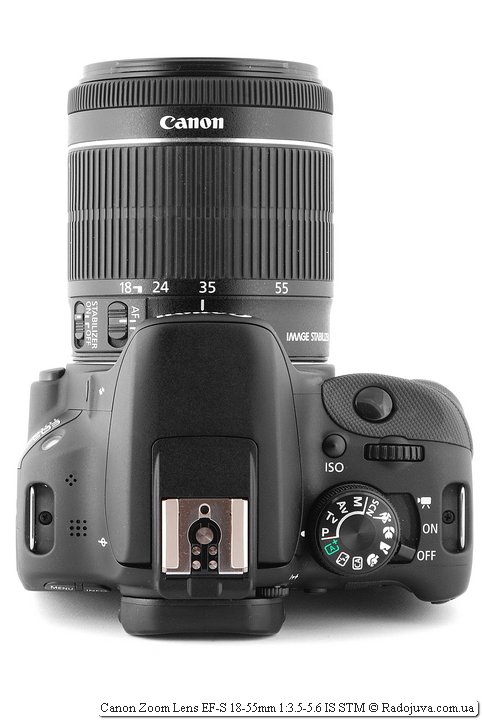
Canon EF-S 18-55 3.5-5.6 IS STM on Canon 100D, view from above
The closest focusing distance is only 25 cm, which makes it easy to shoot small objects up close. The maximum zoom ratio for macro photography is 1: 2.8. The lens barrel has a switch for 'AF / MF' focus mode and 'Stabilizer ON / OFF' mode. The lens uses standard 58mm light filters for Canon kit lenses. Of the useful marks on the body, you can find only the focal length values and a white square - a pointer for attaching to the camera, well, also a mark for attaching a hood.
The Canon EF-S 18-55 / 3.5-5.6 IS STM came to my review without a hood. However, the lens can use the Canon EW-63C lens hood, which fits into special slots near the front of the lens. In principle, the hood can be installed back-and-forth for transportation, in this position access to the focus ring is completely lost.
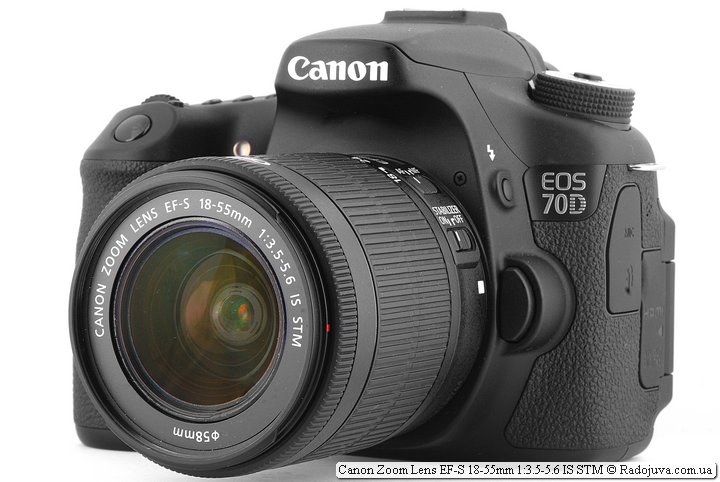
Canon EF-S 18-55 3.5-5.6 IS STM on Canon EOS 70D
Like most modern full-time zooms, the Canon EF-S 18-55 / 3.5-5.6 IS STM creates a high-contrast image, tolerates flare, partially distortion and chromatic aberration the camera can fix itself. I don't see anything unusual in the image quality of Canon EF-S 18-55 / 3.5-5.6 IS STM. But even with such a simple lens, you can squeeze out a lot of good photos, there would be a desire and skill.
On Canon APS-C cameras due crop factor EGF lens (equivalent focal length) will be 28.8-88 mm (18 * 1.6 and 55 * 1.6, where 1.6 is crop factor Canon cameras).
From the sore point: please do not start a discussion in the comments with the 'CAPS LOCK' pressed: 'EF-S lenses are designed for cropped cameras, therefore the focal length does not need to be recalculated'. For cropped cameras EGF recalculated always, for any lens without exception.
Here link to the archive with the originals - 882 MB, 40 photos in .CR2 format (RAW) from a Canon EOS camera 100D.
More examples of photos (with processing) for this lens for Radozhiva kindly provided Alexander Frolov.
Lens prices in popular stores can look at this link, or in the price block below:
Comments on this post do not require registration. Anyone can leave a comment. Many different photographic equipment can be found on AliExpress.
Results
The new Canon Zoom Lens EF-S 18-55mm 1: 3.5-5.6 IS STM turned out to be a good lens. First of all, I want to note the presence of internal focusing, but the focusing itself is very fast and quiet, and even with FTM support. Also, the lens is very light. I believe that Canon has released a great new standard staff member of the 18-55 / 3.5-5.6 class, it's a pity that the flimsy electronic focus ring spoils the overall impression of the lens a little. Overall, the Canon EF-S 18-55 / 3.5-5.6 IS STM is the best option budgetary a regular lens for simple photography for every day.
Material prepared Arkady Shapoval. Training/Consultations | Youtube | Facebook | Instagram | Twitter | Telegram

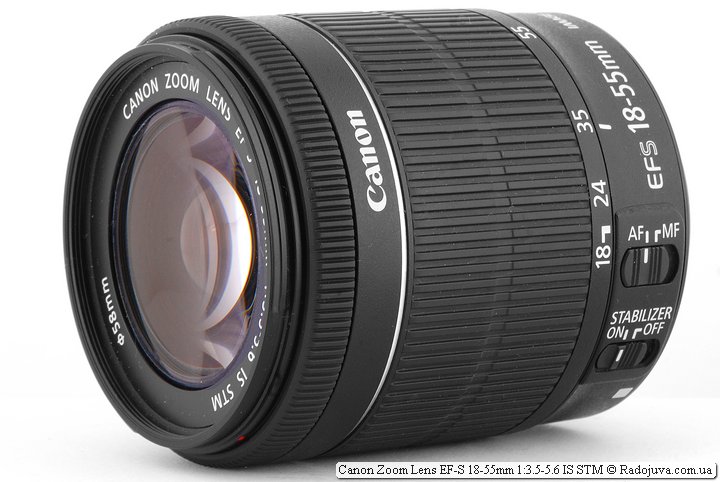

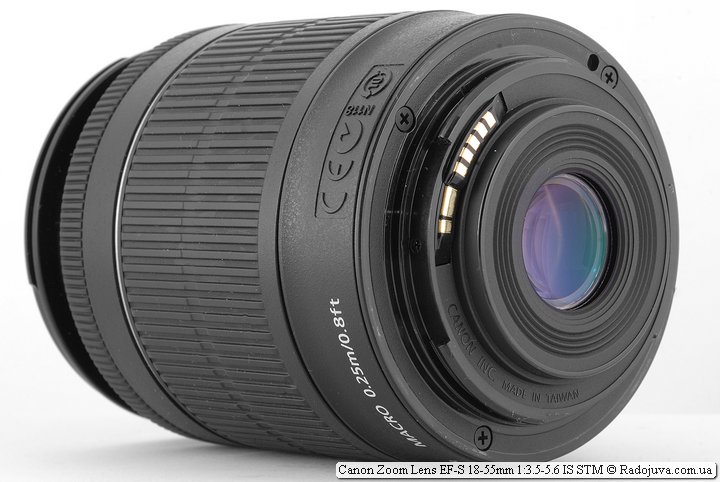
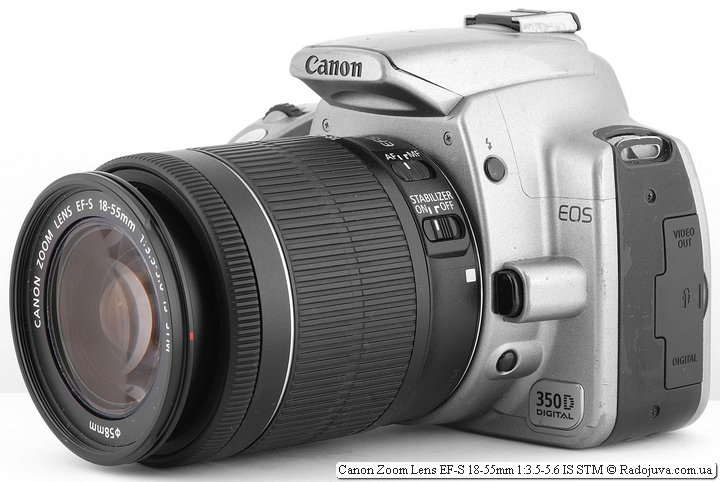































Pretty interesting lens, but I see no reason to buy it if you already have IS II =)
But what about focusing when shooting video?
Shooting a video is more dependent on the camera and its type of focus during Live View. On the Canon 100D, everything is not very, a lot of extra movement. Everything is very good on the Canon 70D.
I understand that soon there will be a review 70D? :)
https://radojuva.com.ua/2014/05/canon-70d/
Is a 4-stage stabilizer cheaper and more reliable than enlightening a 4-stage lens?
if you illuminate the lens, you get a large, bright and expensive zoom
4 stops is 2 to the power of 4, which equals 16. Increasing the luminous flux 16 times is a real challenge. But to remove jitter and make the lens give a sharp picture not from 1/160 but from 1/10 is another matter (it's a pity that all moving objects creep across the frame, because high-aperture optics remain a priority)
Firstly, the optical circuit itself will not allow this to be done. Secondly, for such a purpose, the surface area of the lenses should be an order of magnitude larger. Thirdly, a good optical glass that will not chromate, but will decently keep sharpness at a larger hole, is a rather expensive thing, and the application of an antireflection coating is, in general, a “separate song”. Semiconductors are quite cheap and with streamlined assembly, all this will not be a problem.
I am glad that the regular budget lens survived the update, the sharpness improved over the entire field of the frame (according to photozonde.de, the picture on the open aperture doesn’t so much dull along the edges of the frame over the entire range of focal lengths), internal focusing and a focus ring appeared. A luminosity is needed for portraits mainly, so it copes with all other standard tasks perfectly. Many thanks to the author for the review.
Everything, I am impressed! I am selling my canon ef 40 2,8, I am buying 18-55mm 1: 3.5-5.6 IS STM!
Oh hell he is ef-s
Will not fit my camera.
If you read carefully, then we are talking about a cheap staff card for amateur cameras with the APS-C matrix, which is not a pity to carry on walks, etc., but which nevertheless gives decent picture quality. PS Comparing it with a fix is at least incorrect. For your camera there are completely different staff :)
The wrong system was chosen. Nikon can use cropped lenses perfectly on full-format :)
I just chose the system; Nikon lenses also become on it due to the short working distance. Yes, and native glass with similar characteristics is cheaper. Although the choice is smaller, but the main thing is that you don’t have to learn the lens marking for a month :). (Subjective opinion, I do not pretend to the truth in the last resort. I did not want to offend the owners of Nikon!) :)
I agree with you regarding the working segment! On Nikon using an adapter with a lens, infinity is preserved, but the quality is lost. I prefer to use Soviet optics on a canon, except when using a tripod (I do not have a canon with a rotary screen, but for me it is a very convenient feature and therefore I have to take Nikon d5100).
But with respect to glasses, Nikon is not always more expensive. 18-55 are about the same in price.
Fifty dollars for both are close in price (though Nikon's cheap 50 1.8 will not focus on younger carcasses).
Canon's next fix is 40 2.8, and Nikon's is 35 1.8. 40mm costs about 4500 rubles, and 35 - 6000. But 35mm has a much higher aperture and wider viewing angle. Plus canon only in size.
Nikon's portrait 85mm is slightly more expensive, but also better in reviews and tests. Especially 85 1.8g.
Then there are inexpensive TV sets. Nikon's 55-200 VR and 55-300 VR in terms of tests and personal impressions are slightly worse than the Canon 55-250 IS, although at the price of 55-200 it is similar to the Canon.
In more expensive TV sets, the opposite is true. Canon 70-200 4L is good, but does not have a stub. Having saved 5 thousand, you can buy a stable 70-300 VR from Nikon, which is not much worse than the Canon's brother and is also suitable for a full frame. For me personally, a stub in a telephoto camera is more important than a slightly higher aperture ratio. And Nikon does not attract too much attention - not a zebra :).
With widths, everything seems to be simpler, 10-22 is a little cheaper than Nikon's 10-24, but the sharpness is also slightly weaker. True, here canon prepares a hook on the right in the form of a new 10-18 with a stub - but this is the future.
In general, as you can see from a small comparison, both systems are about the same in price and in the variety of glasses available. In the more expensive segment, Canon wins in the TV range (although 70-200 2.8 are excellent for both companies - Canon has more choice in the range for 200), and Nikon in wide-angle (thanks to 14-24 2.8). So the choice is not as obvious as it might seem.
Arkady, please tell me how do you think canon managed to beat the whale Nikon DX AF-S Nikkor 18-55mm 1: 3.5-5.6GII ED SWM Aspherical (second version)?
GII did not use, it's hard to say.
let’s go on the other hand — do you think there is a fundamental difference in the image of all whale lenses of the 18-55 class of both firms?
This is a slippery issue that concerns Nikon / Canon. The whale lenses that Canon has, that Nikon has released a large number of modifications, some are worse (especially the first ones), others are better, besides the quality spread, etc. If you compare similar models (with a stub or without a stub, etc.), then I believe that the difference in image is not so great.
then it would be better if they did fixes on the crop than produce the same whales. I would be happy to take something wider, such as 24 or 20 for crop, otherwise you will remain without pants with ff lenses on such fr.
If you are really interested in a wide angle, look towards Tokina. I use 11-16 / 2,8 - just a gorgeous lens. But in terms of the combination of convenience-quality photo-price, no matter what anyone says, the regular Nikon kit 18-55 with BP is just excellent. I will not say anything about the Kenons, since I use the D5100.
well, 11-16 is a straight wide duck wide .. 12-28 is more universal, but without aperture .. But so that an analogue of 28 or 35 mm (18 or 24 per crop) with an aperture of 1.8 does not exist ... or rather there is for FF, but they cost 60 thousand each.
So it turns out that only Nikonovsky 10-24 zoom remains in the desired range or a whale lens for the sake of a simple SH, but there are no fixes ((
Therefore, I sit and think, than such torment is it not easier to endure what kind of FF to take, there, though the necessary fixes are available in abundance for normal money - 28 1.8 and 35 2.0 are sane, and fifty dollars (like 35dx) are generally pennies
here everyone says ff expensive, go broke on optics. On zooms, yes, lightly, but on fixes it will be normal
These are wide-angle fixes (and even then not all) will be cheaper. And the simplest portrait 85mm will already be from 15 thousand rubles. For a wide angle crop, there really isn't much choice. If you have a canon, then it makes sense to wait 10-18 with a stub, which the canon will start releasing very soon. In general, 11-16 from tokina is an excellent option for an ultra-wide angle on a crop. But if you don't need an ultra-wide angle, then the question is, why did the whale 18-55 not please you? It is that of Nikon, that of Canon is very, very bad, the quality of the landscapes is just drop dead. For advertising posters 10 meters each may not be suitable, but for an amateur above the roof :)
No, I have Nikon, I’ll take 12-24 from my hands for SHU, 35 1.8 as a full-time aperture. Now I use whale 18-55 just for the sake of SHU. A little further the zoom and aperture drops, and the soap grows.
Thanks for the review, but about the comparison you can see here
http://www.the-digital-picture.com/Reviews/ISO-12233-Sample-Crops.aspx?Lens=836&Camera=736&Sample=0&FLI=3&API=0&LensComp=662&CameraComp=614&SampleComp=0&FLIComp=4&APIComp=1
I think the comparison on this link is not correct, due to the fact that cameras of different classes are compared. Canon 60D crop average price of 25 900 rubles, and Nikon D3x FF average cost of 179 500 rubles.
A small educational program for those in the tank: the 100D is certainly a good initial DSLR (the best DSLR that I personally tried), but all of the above features - fast quiet focus, manual autofocus control - all this has long been in mirrorless cameras, for example, in Panasonic ...
My personal verdict: almost any modern entry-level DSLR - Nikon 3000, 3100, 3200, 3300, 5100, 5200, Canon 1100, 600-650 - any of them will be inferior in autofocus speed, in AF points, in burst speed, in length series, for additional functionality (increasing the focus area by tap, picking, focus control, electronic shutter, silent mode, etc.) not even the newest m4 / 3 mirrorless camera at a similar price.
So keep this in mind when choosing a camera.
but also take into account the likelihood that you will suffer and you fall ill with a photograph)))) And then it will become unbearably painful because you started assembling the system on micro 4 \ 3 And this is not to say that mirroring is bad, no. Mirrorless cameras really have all these buns that Oleg painted, but that's all. And special lenses for portraits or landscapes, reportable autofocus and the absence of noise in the darkness is all here in the mirrors
DSLRs will stop buying when photojournalists shoot in not huge 1dx canon tubes at a football match, when wedding men click small mirrorless mirrors, when there is a tiny micro 4/3 instead of 5dm2 in the photo studio on the tripod, when the best landscape painters in the world say that the Nikon d800 is no longer that and when the choice of lenses for mirrorless will not be limited to 10-15 names maximum. Mirrorless cameras have a lot of pluses and, possibly, the future, but as long as DSLRs prevail in the professional sector, amateurs will also be guided by them.
Mirrorless mirrors are a miracle, but there is one giant BUT! used they are expensive, but the new ones in general space, for this amount you can take a pair of DSLRs for a different mood)))
Dmitry K, there is a lens with an SHU and even a fast lens.) Sigma 18- 35mm F 1.8 DC HSM, like it can already be found on sale. As far as I know, there is nothing like that even on the FF. Dy and generally the maximum aperture ratio of zooms-2.8 in this sense is a unique glass. There are canon and nikon, but it seems that Sony and Pentax will be compatible. I didn’t use it myself, but it would be very interesting to read a competent review on it.) Third-party manufacturers fill the niche of prof. lenses under DX slowly, while the canon (like Nikon) continue to update the glass like the one in the review.
I've read several reviews and reviews for this lens and they vary. Someone says that such aperture in the zoom is something and everything works great. Someone talks about focusing problems. Nobody scolds the sharpness - it is amazing for a zoom, given the aperture. The dimensions are also quite acceptable considering the aperture ratio. There is also a docking station with the ability to fine tune autofocus, but they say this does not always help.
Considering the price and uniqueness of the glass, if you need to have a fast zoom with a wide angle - this glass is ideal. By the way, sigma promises to make a full-frame analog with the same or slightly lower (2.0) aperture.
Well, the FF will be debatable, there are glasses with convenient FR for normal money in bulk. Aperture 2 captivates, I do not argue, but to rest at 50 mm with zoom will be a shame. Now, if they do 18-35 on the FF, then this is a bomb, but this is probably impossible physically (((and even 18-35 with aperture 2.8 will be sweet because native glasses for reporting are mercilessly
Bought a Canon EOS 700D, why don't you buy a kit, and if so, why not?
At 18-135
Tell me about the quality of the optics, I’m going to use it for video, autofocus is not interesting, so if you compare STM and previous whales, is there a difference or not? worth overpaying?
Tell me please. Will this lens fit the Canon EOS 600D?
Of course it does.
Thank you for your reply!
And autofocus will not work when shooting video, right?
When the shutter button is pressed, it will refocus (as with other lenses). The follower will not appear, of course.
There was such a lens in the kit. Tell me, does it make sense to change it to canon 50 / 1.8.
canon 600d camera. I photograph mostly portraits.
There is a sense, but something is better
Hello, Arkady. Thank you so much for a great useful site!
Tell me, please, is it possible to use this lens with a Canon 600D at least for a photo? Or tell me which lens is better to take to familiarize yourself and get the first practice with an amateur DSLR. And then the carcass turned up at a good price and now I am tormented by what lenses to buy for it.
And yet - I am also considering the EF-S 55-250mm f / 4-5.6 IS - is it advisable to buy it, or is it better to look for something else?
Sincerely, Paul.
Beggar student, I recommend buying a native Canon 18-55 with a stabilizer first. It's better with an STM motor, but not essential. It is versatile in focal lengths for most beginner photography needs. Next - buy an adapter М42-EOS and Helios 58 f2.0, you will feel what high-aperture optics are (and manual focus at the same time). EF-S 55-250 mm indoors can only be used for a bust portrait of 55 mm, I think that it is not convenient for indoor use, it needs space: park, forest, beach, etc. I do not recommend EF-S 55-250 mm as the first and only lens!
I’ll even say more interesting, because someone will read it all the same. General advice on lenses, take any 18-55 with a stub, take a year on the machine, take a helios from a friend and take a day off and cross, look at your photos on a whale on which focal points you shot, be surprised that they are diverse, take from a friend brandyts take a week off, give and use your whale and enjoy its versatility and an excellent picture in auto modes))) then try manual modes, analyze what you won, switch to auto, post an ad for the sale of kame s, sell, report money and take a sony’s mirrorless mirror and enjoy compactness, excellent shots, and now you can shoot great videos and always take your camera with you without tearing your back and carrying an extra bag, the rest will be done automatically by you, you’ll just receive good pictures and enjoy life)
P.S. about telephoto, above 70 on crop you will never need it in real life, only if you need to reach something far away but the picture will be similar to a soap box for 1000 rubles, you will have to learn how to draw in the editors)))
With myself, regardless of the dates ... The diagnosis ...
I turned it over, and therefore made a note in the first post that someone would read it anyway, the date does not matter)
Well done, famously told everything, truthfully. People, listen to smart people.
My wife gave me a 700D carcass, my lenses are not suitable for video ... .. I just need a new line, so the question is, what is better to buy Canon EF-S 18-55 / 3.5-5.6 IS STM or Canon EF-S 18-135 / 3.5-5.6 IS STM? Is there a difference in quality, or is it just a focal length?
I recommend 18-135. There are differences. But 18-135 is much more convenient.
Thank you very much! It is very important when people help with the choice! And thanks for the review! I like to shoot aquarium fish, well, the video is also relevant, so the shooting distance was 25 cm, but my intuition suggested that the 18-135 with a metal mount should somehow be more impressive ….
And finally I bought this wonderful creation 18-135 IS STM .... While very pleased with it, the focusing is delightful .... Thanks again Arkady for the review and recommendation ... ..And a new question! I want to adapt a polarizing filter to it, I live in nature, I'm sure it should come in handy! Is there a difference in these filters for a new type of lens, and in general, what brand and model would you recommend? Thank you….
I was told that 18-55 stm will not work with my 60 d. Is it so?
I’ll answer late, maybe someone will help someone, STM in focusing PHOTO will work fine, almost like USM in speed and silently. In VIDEO, the Kenon 60d itself does not twist the focus, and so any lens can be focused only by half-pressing the shutter release button or af-on button.
Thank you! I learned a lot of new things, not just technical data, real impressions. I need an easy staffer for video, but for the photo there are 18-135 (without STM). And, as a staffer for the 70-D itself. In addition, it is heavy, because video is being shot on the screen. I think it will be a great solution. Thanks again!
I would like to give an opinion on a common question. Very often on the forums and here, too, some people note with some pathos that they say some lens was made not in China but in Thailand. And now he will think - why In Thailand? The answer is very simple - because in Thailand, this is the country where the cheapest labor of those countries, which in one way or another neighboring China. Why China? Because there are no spare parts factories in Thailand, and almost all parts of the manufactured products must be supplied again from China. So we get that the goods produced in Thailand are the same goods from Chinese components, but produced by a much cheaper and low-level labor force ...
One thing all sorts of whale mass lenses, but when some Carl Zeiss with the price tag OVER 9000 has the inscription “Made In Thailand”, and even from the side of the bayonet insides, so that no one can see when the lens is mounted on the camera, it causes embarrassment.
Good day.
I want to purchase 18-55 STM for shooting video and photos, the simple question is it is better in terms of photo than 17-85USM
It is better, if only because the loop does not break like that.
FTM was in the first version of the pentax 18-55 short kit. It is difficult to remember exactly which year it is, but it was definitely bundled with the K10D, which means it already was in 2007. At what, interestingly, a screwdriver and an FTM coexisted, i.e. something like a slipping disc clutch was used. Not every premium glass comes across such a solution.
The pentaxists on the forum did not recommend using this function often, because the friction clutch is quickly erased. And this is not exactly FTM, although the solution is unique - I have not seen this anywhere else.
18-55 stm
Sample photo
Sample photo 18-55